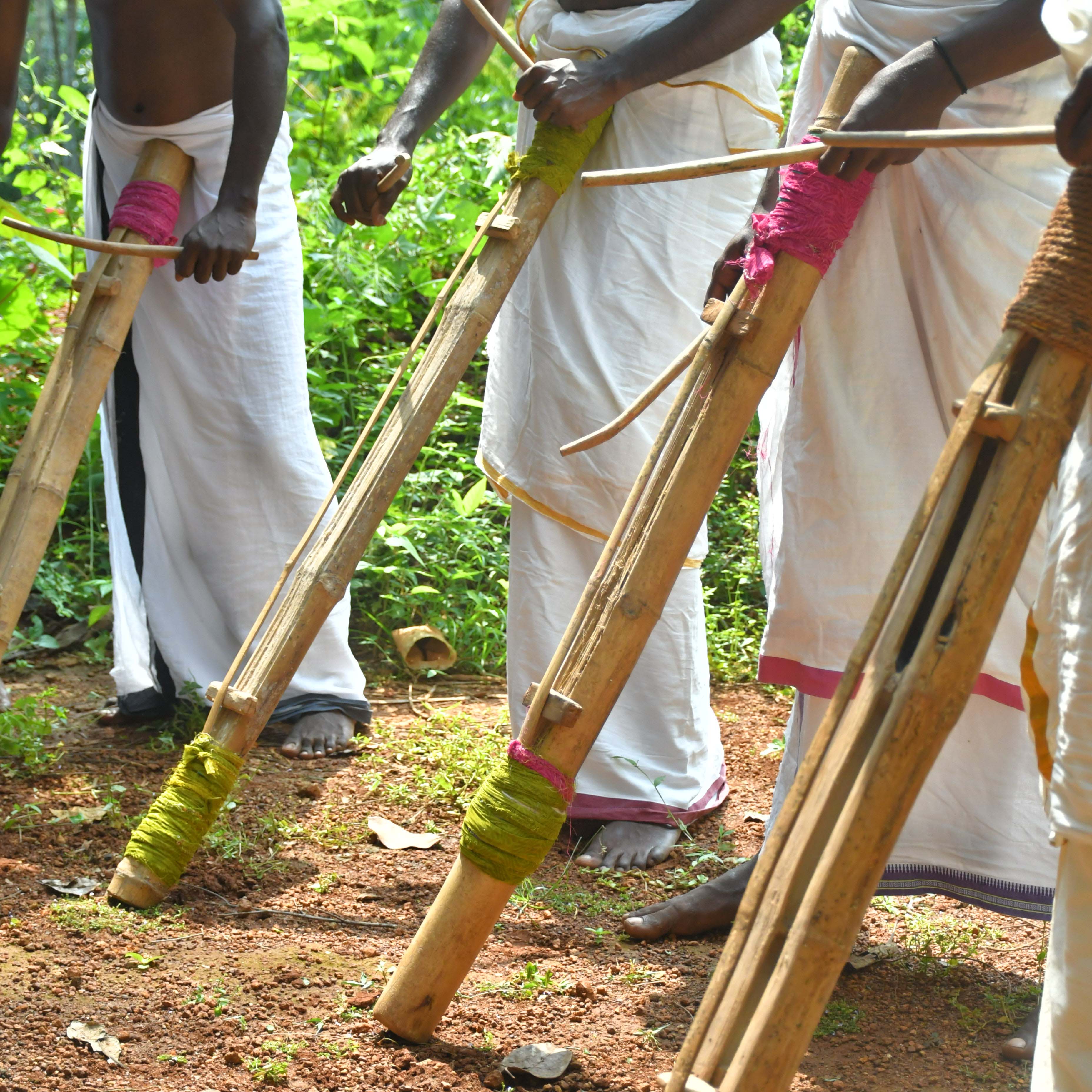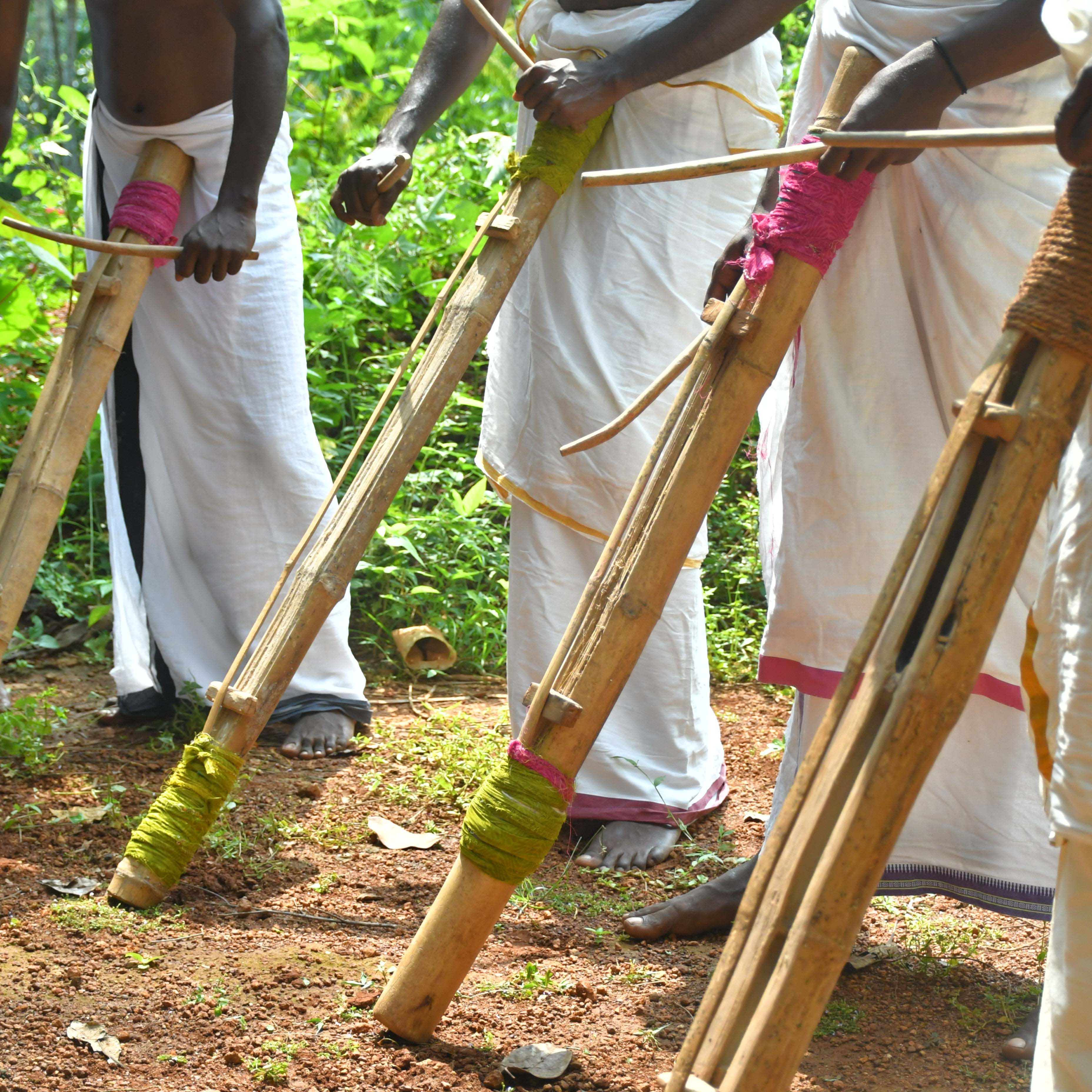What you'll learn
- Cultural Foundations : Comprehend the historical and cultural significance of Mulam Chenda in the Mavilan community.
- Instrument Construction : Discover the requisition of bamboo, design, and the traditional process of making Mulam Chenda.
- Playing Techniques : Learn the proper techniques for control of strokes and tamber for an acoustic instrument.
- Musical Integration : Discover classic ceremonial use and new assemblages mixed with modern music.
- Preservation & Sustainability : Discuss what’s currently being done to safeguard traditional knowledge and encourage eco-aware manufacturing
Couse Features:
- Tribal Expert Insights : True wisdom of the bushmen musicians and craftsmen.
- Hands-On Crafting Guides : Easy to follow steps for making and tuning your Mulam Chenda on your own.
- Rhythmic Practice Tools : Tribal rhythm pattern learning aid audio visual aid.
- Cross-Genre Exploration : Performances of Mulam Chenda in folk and modern musical forms.
- Sustainability Focus : To produce informational content on sustainable bamboo harvesting and environmental impact.
Who Should Enroll
- • Musicians who want an ethnic percussion instrument
- • Those who study cultural heritage and tribal art
- • Producers interested in old school textures.
- • Manufacturers of instruments and of acoustical devices
- • On folk and indigenous studies educators and students
Description
MULAM CHENDA
The evolution of Mulam Chenda is an indication of the shifts in tribal living patterns and its influences from other musical traditions of Kerala. This study aims to discuss about the origins, cultural values and the changes of the age-old Mulam Chenda.
Origins and Early History
The Mulam Chenda has its origins lost in the mists of time, deeply rooted in theish of the Mavilan tribe, one of Kerala’s many indigenous people. The Mavilan tribal settled in hilly and forest tracts and used bamboo for making houses, tools and implements. So, Bamboo being ample in quantity and versatile in its uses, it became a very viable option to use it in fashioning the Mulam Chenda.
Cultural Significance
The Mulam Chenda is not just a musical instrument, it is a medium of culture and arts, occupying a prominent place during tribal feasts and rituals. Drum plays traditionally includes practices during the harvest season, nuptial rituals, and the like, as it serves as a cacophonous background to the celebratory mood. The beats produced by the Mulam Chenda represent the tribal unity, and this leads to the confluence of the Mavilans.As a result of these contacts the Mulam Chenda has come to be an integral part of Mavilan cultural identity and a symbolic representation of their links to their ancestors and land.
Cultural Relevance in Mavilan Tribe
The instrument is no longer simply a musical instrument, becomes a vessel for storytelling, spirituality and community bonding. Considering the cultural significance of the Mulam Chenda, a study of its meaning in the different forms of Mavilan life such as rituals, social get-togethers, identity formation and communication across generations would be a definite plus.
The Role of Mulam Chenda in Rituals and Ceremonies
The Mulam Chenda is an instrument of high significance in the rituals and traditions of the Mavilan community. It is typically used during agricultural celebrations, weddings, and religious ceremonies, acting as a strong ethno-cultural connector between the community and its traditionality. The deep, hollow sound of the drum is the heartbeat of the village and sets the tempo of community life by providing a dynamic ambience to strengthen social cohesion.
Social Gatherings and Community Identity
In large parts of the aboriginal world music and dance serve as communicative means. Rhythms of the Mulam Chenda are a language, through which inhabitants express their emotions, stories, and group history. Frequently the narrator sings a traditional song to the rhythm of the drum as those gathered together at the drum's beat, or songs that tell the stories of their ancestors for help, love, strength and defence in war and have a group memory who remember them from the past.In addition, the Mulam Chenda is a means of resistance to cultural dilution. While today’s modernity and globalization are having to creep into their age-old ways, the musical traditions of their forefathers as harboured in the Mulam Chenda is a strong statement of assertion of their cultural space by an iconic tribe in the Malabar region. By participating in such performances and sustaining their ancestral rhythms, the Mavilans reclaim their distinct cultural identity in a world that is fast changing around them.
Spiritual Connections and Symbolism
Drumming is seen as a worship and the beats speak to the spiritual forces, calling upon blessings and protection for the community. The drum itself is considered a religious object and its manufacture includes rites and ceremonies that express the Mavilan philosophies. Bamboo selection, drum processing and pre-use rituals are used to respect religious belief.Further, the all of this, in combination with accomplished musicians in the community , adds value to the teaching and learning process across generations. Their act is an inspiring, exemplary lesson featuring the sweetness of the Mulam Chenda and the gaiety of Mavilan tribe. Through watching such acts, younger generations are able to feel the artistic and cultural value of their tradition.
Information about Mavilan Tribe
Mavilans are one of the tribals in the Southern state of India, Kerala, who mainly inhabit the hilly and forest areas of Malabar region.
Historical Background
Throughout its history, Mavilans have experienced numerous encumbrances, among them being attacks from outside, e.g. colonial powers and landlords. Published accounts of these confrontations are usually associated with subsequent functional marginalisation, at the expense of indigenous societies in the practice of their own traditions. Yet despite these challenges, the Mavilan tribe has been able to hold onto their traditions, sometimes by integrating with the mainstream culture and sometimes just by maintaining a sense of who they are.
Practices and Traditions Around the World
The Mulam Chenda is one of their fundamental musical instruments and features prominently in festivals, celebrations, rituals and community identity and spirituality. The Mulam Chenda rhythms accompany native songs and dances which enhance the social structure and cultural symmetry of the society.
- Festivals and Rituals: Songs and dance are an important part of such festivities as the harvesting festival, the marriage ceremony and religion worship, accompanied by the sound of the Mulam Chenda.
- Economic Activities: In recent years the Mavilans have been subject to economic pressures resulting from altered land use, the destruction of the forest, and intrusion of the commercial agriculture. These alterations have put their traditional means of livelihood at risk, making many of the tribe members look for additional sources of income such as working in neighbouring towns or engaging in tourism activities.
Construction and Design of Mulam Chenda
Bamboo Selection and Preparation
The bamboo poles are then prepared in a variety of ways once harvested. The bamboo is firstly cleaned so as to wipe out dirt. After cleaning, the poles are cured to improve their wear resistance. Curing may include air drying or placing the fruit in the controlled atmospheres to reduce moisture and prevent mould growth. When the bamboo has dried sufficiently, it is cut into lengths of approximately one meter, as is the case with the Mulam Chenda. The ends are exposed to allow sound to reverberate.
Instrument Structure: Open Ends and Acoustic Properties
Structure and Design
Their drum usually has two open sides that let out air waves freely, providing a deeper and more opulent sound. This bamboo used in the drum are about a metre in length and are firmly tied together with sturdy ropes which becomes stable as well as makes it easy for making sound to come out of them.Slender rods are attached at the center of the lengths of these thin, long pieces of bamboo material, which make up the predominant striking surface. Musicians strike those sticks with mallets that are designed for just the purpose, and the tones that ring through the body of the drum are bright.
Acoustic Properties
The construction affects the timbre of the instrument, or the quality of sound which makes it distinct. It adopts bamboo material, which makes the speaker lightweight and compact, and the hollow design makes the sound wider, fuller and more transparent. Musicians frequently take advantage of these acoustic effects, producing complex rhythmic patterns that characterise Mavilan songs. Sound can be manipulated with various striking techniques and in turn offer a wide range of musical possibilities. Changing the force and angle of their strikes allows players to generate everything from sharp, staccato notes to deep, resonant tones. This flexibility is crucial for the performance of the Mulam Chenda in ritual music, where it is frequently used to accompany dances and chants.
Tribal Techniques for Crafting and Design
- Material Selection
- Preparation of Bamboo
- Construction Techniques
- Sound Optimization
- Symbolism and Cultural Implications
- Knowledge Transmission
- Challenges and Adaptations
Playing Techniques and Sound Production
When the Mulam chenda is played, it is beaten with slender sticks which are to strike the bamboo pieces. Striking differs according to method to produce tone and rhythm. In the old way, drummers play in a circle, which creates a powerful spirit of community per the proverb. The rhythmic part often has a kind of call-and-response style instead, as one drummer lays down a beat and the others succinctly respond, weaving a complex, yet explosive rhythmic soundscape.The Mulam Chenda has an important place in Mavilan community during festivals, rituals and community meetings. It is danced in time with traditional dance and serves as an integral part of such celebrations as Theyyam, where the sounds echo the stories and the values of the tribe. The custom helps to keep alive not only the musical heritage, but also the social ties that make the Mavilans a people.
Basic Playing Techniques for Mulam Chenda
- Fundamentals of Playing: The drummer usually sits cross-legged with the dhol resting between their knees, with an inclination for a firm push of air through each side of the dhol. It is played with two sticks; one thick and one thin. This difference in stick size allows for a lot of variation in tones and dynamics.To make sound, the players hit on various spots of the bamboo surface. The central area gives you the deeper bass you are looking for, and strikes closer to the edge result in sharper, more focused notes. It is not as easy as it looks; the placement and force of the hits are critical to the sound of the drum.
- Rhythmic Patterns and Exercises: The Ganapathi Kai, made up of a 37-count sequence of special beats and prayers to Lord Ganesh, is one of the most common exercises in the repertoire of exercises that are often used in the beginning of a practice session and forms a blend of traditional rhythm with the art of prayer.Yet another important factor in acquiring the skills in the Mulam Chenda is to practice different Talas or rhythmic modules, termed as “Sadhakam”. They're not drill and kill exercises to be practiced in isolation, but rather repeated exercises that drummers play to put different rhythms into their bodies and prepare themselves for performance.
- Cultural Context and Performance: The performance of the drum and its contexts can range from the temple festivals to the community settings, where the drummers are required to be capable of improvisation and to modify the rhythms to accommodate the occasion. This flexibility is important, as performances often interract dynamically with other artistic forms (eg dance and song) further enriching the collective event.
Rhythm Patterns and Tribal Rhythmic Influence
Historical Context of Rhythmic Patterns
Typical Kerala music includes several different varieties of songs that are sung with varied beats. These are typically based on temple or folk tradition and the chenda is the lead/most prominent accompanying instrument.
Structural Elements of Rhythm Patterns
Patterns The beating of Mulam Chenda’s rhythm is of different pattern identified by different names, which may change according to the nature of the performance. Classical compositions generally employ Taala as the rhythm, which divides beats into cycles. As it were, in tribal folk we have the popular Taala of Adi Taala formed from an 8-bean cycle that is the platform for improvisation and intricate rhythmic manipulations.
Influences from Other Musical Traditions
The beats of Mulam chenda are also based on local musical traditions in Kerala; its rhythms reflect the revival of the tradition which we find in Karnataka and Sopana Sangeetham. These styles overall help to understand the range of rhythm and emphasize the use of Gamaka and Konnakol, both of which are often incorporated into Mulam Chend drumming. a
Role of Mulam Chenda in Tribal Rituals and Celebrations
The Mavilan's traditional ritual is incomplete without Mulam chenda when festivals, weddings, and social fetes are celebrated. It is believed that the rhythmic sound of the drum brings blessings from the gods and the ancestors and engenders a feeling of sanctity and that ecstatic state of harrowing. Folk songs find a place everywhere for its life in soul and beauty in its simplicity. It is a rich, varied and combination of history, culture and customs besides very good poetic and literary tradition. It is deeply linked with the culture, history and life of the people.When it is played in Theyyam, the drum's thunderous roaring sound rings out, enhancing the divine atmosphere at the Theyyam, a sacred, ritual dance that respects local deities. The music from the Mulam Chenda not only raises the tempo of the performance but also brings the people closer to their roots allowing the community to share the native tales of the tradition.
Musical Application and Rhythmic Compositions
- Compositional Techniques in Mulam Chenda Music: Rhythm A basic characteristic of Mulam Chenda Composition is the rhythm pattern which rests on both repetitive and syncopated patterns most of the time. They form guidelines which give freedom for musicians to improvise and express themselves while still playing within a given structure. The cycle is usually regarded as a corresponding to a certain tala, but it can be of any arbitrary but defined length.
- Modern Applications: Fusion with Contemporary Music: Fusion music and the traditional bamboo drum instrument Mula Chenda the emergence of Mula Chenda, the tribal drum of Mavilan community as an instrument of fusion in modern music. Musicians are venturing into domains such as jazz, rock and electronic, where traditional instruments like the Mulam Chenda is used. This cross-cultural collaboration not only makes old sounds new again, but also does a hell of a job dragging folk instruments into the modern music world.
Preservation, Modern Influences, and Conclusion
Environmental Sustainability: Bamboo Harvesting and Usage
Sustainable harvesting or the bamboo is an essential requirement for the survival of the Mulam Chenda tradition, and the Mavilan community in general. Management of bamboo clumps Sustainable management of bamboo is important in ensuring the health and productivity of the clumps. Responsible harvesting methods ensure only the mature bamboo is used, while younger shoots continue to replenish the grove and maintain the natural balance of the surrounding forest. These efforts stress the importance of bamboo as a traditional material such as the Mulam Chenda, but a sustainable resource for the ecological and social well-being too.
Challenges and Future Prospects of Mulam Chenda
A major factor is that younger generations are gradually becoming less fascinated with conventional art forms in their lives, which is due to the influence of the modern day and the act of urban living taking precedence over these activities. Such amalgamation of instrumental music in festivals are found to be declining where the traditional craftsmen of the Mulam Chenda numbered few. Through combining with popular music of the time while incorporating time-honoured pattern, the artists will be able to create new compositions that appeal to various music lovers, thereby, bringing the Mulam Chenda to the attention of national and international music temples.
Conclusion
The mulam chenda thus, is a strong facet of cultural and musical heritage of the Mavilan tribe of Kerala. Even though there are problems, such as the younger generation’s waning interest and the vanishing of skilful craftsmen, it is still hopeful that the instrument can be preserved and regenerated. Through education, community involvement, and artistic innovation, the Mulam Chenda has a chance to find a future that honours its past but also accommodates the new.






